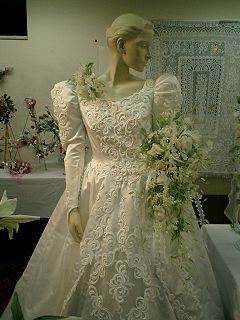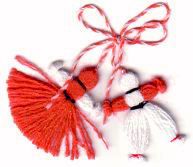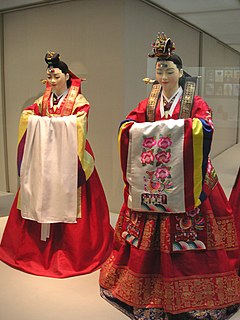This article has no lead section .(October 2022) |
This article needs additional citations for verification .(October 2022) |


This article has no lead section .(October 2022) |
This article needs additional citations for verification .(October 2022) |


The Bulgarian national garbs appear from the Bulgarian National Revival to the middle of 20th century. The women's costume are composed of: pinafore, skirt, buckles, apron, Bulgarian jewelry and others. The men's costume are composed of: full-bottomed breeches, girdle, vest, shirt and others. During the Bulgarian National Revival Bulgarians manufactured themselves the Bulgarian national garb. [1]
Bulgarian traditional clothing is diverse, and every ethnographic area in Bulgaria has its distinct styles. Bulgarians call their traditional clothing 'носия' (nosiya).
Each nosiya is unique to the person wearing it. They were embroidered with symbols called 'шевици'. These 'shevitsi' were special because they showed the personality, status, goals, and wishes of the wearer. The embroideries on the clothes were not just patterns, but ancient motifs passed down from generation to generation. Few know how old this tradition is. The cut of the Bulgarian skirts and dresses, the embroidered ornaments on them, etc. are at least 3500 years old. The embroidered ornaments are part of the Bulgarian folk art, which originates from the ancient art of Slavs and Proto-Bulgarians, enriched by the influence of other peoples with whom the Bulgarian ethnic group has had contact over the centuries. We find similarities with the cultural traditions of the peoples of Tibet, China, Mongolia, Central Asia, Volga Bulgaria, Danube Bulgaria, and others. The prototype of the embroidered ornaments is considered to be the tattoo of the naked body. With the advent of fabrics, these ornaments are transferred to clothing. This happened during the Bronze Age of Thrace, and the origin of many of the motifs is even more ancient - they appear in the Copper-Stone Age.
Bulgarian embroidery ornaments developed with the development of Slavic and Proto-Bulgarian culture. With the unification of the two peoples, the intertwining of embroidery ornaments from both cultures gradually began to be observed. It was believed they protected the human body from spells and evil spirits. People believed that if someone cut off part of the embroidery of a garment, it gives way to evil spirits and makes a person more vulnerable. Bulgarian maidens were allowed to embroider only until their wedding. After that, they had the right to do so only when their daughters turned 12 and it was good to teach them. The girls began embroidering their chaise at the age of 12, and this was the highest art form created at home by anyone else. Some examples of shevitsi are:
One of the oldest ornaments. The crown represents the firmament (upper, celestial world) with its real and supernatural inhabitants - God, angels, saints, and birds. The trunk separates Heaven from Earth and corresponds to the middle, earthly, human world. The roots symbolize the underworld. It is the Axis of the world, the connection between the earth and the sky, it is a symbol of the Circle of Life - every spring, it leaves again, and when winter arrives, all the leaves fall off.
It represents three intertwined eights, forming an endless labyrinth and is one of the symbols of protection used by Bulgarians' ancestors. It embodies the idea of the interconnectedness of everything in the universe. It is believed that the Celestial Turtle, also called the Space Turtle, Pletenitsa, originated from the ancient Proto-Bulgarians and was a symbol of the god Tangra.
People believed that the cross protected them from diseases and all kinds of troubles. As the population gradually became Christianized, the cross took on a new meaning and started being perceived as a symbol of the Christian God.
These are two triangles that have merged their tops, forming a wedding sign. This figure contains the concept of the divine and earthly nature, of the masculine and feminine, of the pursuit of harmony and balance.
The Mother Goddess was depicted as a pregnant woman giving birth, with the sun and the moon on either side of her. It was a symbol of fertility.
The swastika was sacred. It was a symbol of the god Svarog. It was believed that it had a protective function to protect against evil, and at the same time attracts prosperity, fortune, and fertility. However, after Adolf Hitler, this symbol became taboo amongst Bulgarians.
The colors of the shevitsi mattered, too. People would embroider with specific colors for specific reasons.
The color red symbolizes blood and fire, life and fertility. It protects against evil forces and animals waking up in early spring (with the warming of the weather), protects against black magic, and spells. Red is associated with masculine strength and courage, and for women - fertility and vitality. Because of this, during weddings in some regions of Bulgaria, the bride wore a red veil. In the rituals of the ancient eastern peoples, reproducing the "sacred marriage" between heaven and earth, red was used to depict the earth. For many ancient peoples such as the Romans, Greeks, and Egyptians, red was also a leading color in rituals and ceremonies.
The green color is a symbol of nature, freshness, health, and youth, reviving nature and hope. The color green is also associated with the Tree of Life - the universal human symbol of the universe, with immortality and eternity. It is a known fact that contemplation of the color green calms the psyche.
Yellow or "gold" is a symbol of the Sun and light, of the divine and the sacred, of moral purity and mercy, of prosperity and wealth. Studies show that yellow helps to increase brain activity and improve memory. In Christendom, the "golden" symbolizes God and the sacred.
The blue color represents the sky, space, and water. It embodies truth and trust, purity, serenity, and contemplation. Blue is the color of angels, at high spiritual levels. It is often used in combination with its "opposite" warm red color. Most often this happens by comparing or "merging" the sky (blue) and the earth (red, as we mentioned above).
Most cultures associate white with purity, truth, and innocence. In different Bulgarian regions, white can be interpreted in several ways. In the Eastern Rhodopes, it is customary to make a wedding mask for the bride with white paint and colored beads. On the other hand, although rare, white has been associated with death. In the Strandzha region for centuries, the mourning was in white, because the haiduti who went to the gallows were dressed in white shirts. White is also a symbol of wisdom, knowledge, and infinity.
A white wedding is a traditional formal or semi-formal wedding originating in Great Britain.

A wedding dress or bridal gown is the dress worn by the bride during a wedding ceremony. The color, style and ceremonial importance of the gown can depend on the religion and culture of the wedding participants. In Western cultures and Anglo-Saxon cultural spheres, the wedding dress is most commonly white, a fashion made popular by Queen Victoria when she married in 1840. In Eastern cultures, brides often choose red to symbolize auspiciousness.

A Martenitsa is a small piece of adornment, made of white and red yarn and usually in the form of two dolls, a white male and a red female. Martenitsi are worn from Baba Marta Day until the wearer first sees a stork, swallow, or blossoming tree. The name of the holiday means "Grandma March" in Bulgarian and Macedonian, the holiday and the wearing of Martenitsi are a Bulgarian tradition related to welcoming the spring, which according to Bulgarian folklore begins in March. Inscribed in 2017 on the UNESCO Representative List of the Intangible Cultural Heritage of Humanity.
Perkūnas was the common Baltic god of thunder, and the second most important deity in the Baltic pantheon after Dievas. In both Lithuanian and Latvian mythology, he is documented as the god of sky, thunder, lightning, storms, rain, fire, war, law, order, fertility, mountains, and oak trees.

A rushnyk or rushnik is a decorative and ritual cloth. Made of linen or cotton it usually represents woven or embroidered designs, symbols and cryptograms of the ancient world. They have been used in sacred Eastern Slavic rituals, religious services and ceremonial events such as weddings and funerals. Each region has its own designs and patterns with hidden meaning, passed down from generation to generation and studied by ethnographers.

The Hopi people of North America viewed snakes as symbols of healing, transformation, and fertility. For example, the Hopi people of North America performed an annual snake dance to celebrate the union of Snake Youth and Snake Girl, and to renew fertility of Nature. During the dance, live snakes were handled and at the end of the dance the snakes were released into the fields to guarantee good crops. "The snake dance is a prayer to the spirits of the clouds, the thunder and lightning, that the rain may fall on the growing crops.." In other cultures snakes symbolized the umbilical cord, joining all humans to Mother Earth. The Great Goddess often had snakes as her familiars—sometimes twining around her sacred staff, as in ancient Crete—and they were worshipped as guardians of her mysteries of birth and regeneration. Although not entirely a snake, the plumed serpent, Quetzalcoatl, in Mesoamerican culture, particularly Mayan and Aztec, held a multitude of roles as a deity. He was viewed as a twin entity which embodied that of god and man and equally man and serpent, yet was closely associated to fertility. In ancient Aztec mythology, Quetzalcoatl was the son of the fertility earth goddess, Cihuacoatl, and cloud serpent and hunting god, Mixcoatl. His roles took the form of everything from bringer of morning winds and bright daylight for healthy crops, to a sea god capable of bringing on great floods. Where there are images of the sky serpent with its tail in its mouth, it is believed to be a reverence to the sun, for which Quetzalcoatl was closely linked.
Indian wedding cards are cards that are made and distributed to invite guests to the wedding ceremony and to honour and commemorate the wedding of two people. Since the medieval period, Indian wedding cards have carried great importance in the Indian subcontinent, and are known through several names such as :निमंत्रण पत्र/पत्रिका,. These invitation cards are used for announcing the marriage ceremony and this process of sending an invitation card to guests and relatives forms an integral part of the ritual. Simultaneously, these cards are famous throughout India for their unique patterns, colors and symbols. The presence of these different elements in a marriage card makes it appropriate for the matrimonial ceremony, and without it the event would be considered incomplete or unsuccessful.

The dress of the Armenians, also known as Armenian traditional clothing, reflects a rich cultural tradition. Wool and fur were utilized by the Armenians along with the cotton that was grown in the fertile valleys. During the Urartian period, silk imported from China was used by royalty. Later, the Armenians cultivated silkworms and produced their own silk.

The tradition of egg decoration in Slavic cultures originated in pagan times, and was transformed by the process of religious syncretism into the Christian Easter egg. Over time, many new techniques were added. Some versions of these decorated eggs have retained their pagan symbolism, while others have added Christian symbols and motifs.

Ukrainian embroidery occupies an important place among the various branches of Ukrainian decorative arts. Embroidery has a rich history in Ukraine, and has long appeared in Ukrainian folk dress as well as played a part in traditional Ukrainian weddings and other celebrations. Appearing all across the country, Ukrainian embroidery varies depending on the region of origin. From Poltava, Kyiv, and Chernihiv in the east, to Volyn and Polissia in the northwest, to Bukovina, and the Hutsul area in the southwest, the designs have a long history which defines its ornamental motifs and compositions, as well as its favorite choice of colors and types of stitches.

A bojagi is a traditional Korean wrapping cloth. Bojagi are typically square and can be made from a variety of materials, though silk or ramie are common. Embroidered bojagi are known as subo, while patchwork or scrap bojagi are known as chogak bo.

Chinese culture attaches certain values to colors, like which colors are considered auspicious (吉利) or inauspicious (不利). The Chinese word for "color" is yánsè (顏色). In Classical Chinese, the character sè (色) more accurately meant "color in the face", or "emotion". It was generally used alone and often implied sexual desire or desirability. During the Tang Dynasty, the word yánsè came to mean all color. A Chinese idiom which is used to describe many colors, Wǔyánliùsè (五顏六色), can also mean colors in general.

White is the lightest color and is achromatic. It is the color of objects such as snow, chalk, and milk, and is the opposite of black. White objects fully reflect and scatter all the visible wavelengths of light. White on television and computer screens is created by a mixture of red, blue, and green light. The color white can be given with white pigments, especially titanium dioxide.

Hwarot is a type of traditional Korean clothing worn during the Goryeo and Joseon Dynasty by only royal women for ceremonial occasions and later by commoners for weddings. It is still worn during the p'yebaek phase of modern weddings. Before commoners wore hwarots, they wore wonsam due to the steep cost of a hwarot. The gown is typically worn with a jokduri or hwagwan, binyeo or daenggi, and yeongigonji, which is red and black makeup spots on the cheek and brow.
The Sujani embroidery work of Bihar, is a textile expressive art product, given protection under the GI registration act. It is usually a quilt or bed spread, which was earlier made of old clothes, but is now generally made of easily available fabric with embroidery done with the most simple stitches with motifs narrating stories. It is exclusively made by women in 15 villages of Bhusra in the Gaighat block of Muzaffarpur and a few villages of Madhubani in the Indian state of Bihar.

Gorga is a form of artistic decoration found in the culture of Batak Toba in North Sumatra, Indonesia. The gorga motif is in the shape of flourishes and undulations. The motif is either painted or carved onto wood using three colors: white, red, black; each corresponds with different realms in the Batak Toba cosmology. Gorga motif is often found in Batak Toba architecture e.g. a Batak Toba house or objects e.g. music instruments. They are meant to protect the building or object from spiritual harm e.g. evil spirits sent from neighboring village.
Chuvash national symbols - spiritual symbols of ancient Chuvash, are valuable historical and cultural heritage of Chuvashia. Symbols are used in national ornaments of embroidery, jewelry, artwork, etc.

National symbols are the sacred attributes for Ukrainian people. In Ukrainian graphics there exist a number of symbols and images from national songs, legends. Such symbols and imagery are used in national customs and rituals. They are reproduced in embroidery on national costumes, ritual cloth—rushnyks, painted on crockery, in forged products, in carving, in bas-relief house decoration, in hearth painting, pottery, engraving and also in Ukrainian traditional Easter eggs—pysankas.

Suzhou embroidery, Su embroidery or Su xiu is the embroidery created around the city of Suzhou, Jiangsu, China. It is one of the oldest embroidery techniques in the world and is the most representative type of art in Chinese embroidery. It already has a history more than 2,000 years and is an important form of handicraft in the history of Chinese art and folk custom, representative of Chinese traditional folk arts. It is famous for its variety of stitches, beautiful patterns, elegant colors, and consummate craftsmanship.
Chinese auspicious ornaments in textile and clothing refers to any form of Chinese auspicious ornaments, which are used to decorate various forms of Chinese textile and clothing, fashion accessories, and footwear in China since the ancient times. Chinese auspicious ornaments form part of Chinese culture and hold symbolic meanings. In ancient China, auspicious ornaments were often either embroidered or woven into textile and clothing. They are also used on religious and ritual clothing and in Xifu, Chinese opera costumes. Auspicious symbols and motifs continue to be used in present day China in industries, such as home textiles and clothing; they are also used in modern design packaging and interior design. Some of these Chinese auspicious ornaments were also culturally appropriated by European countries during the era of Chinoiserie, where they became decorative patterns on fashionable chinoiserie fashion and textiles.